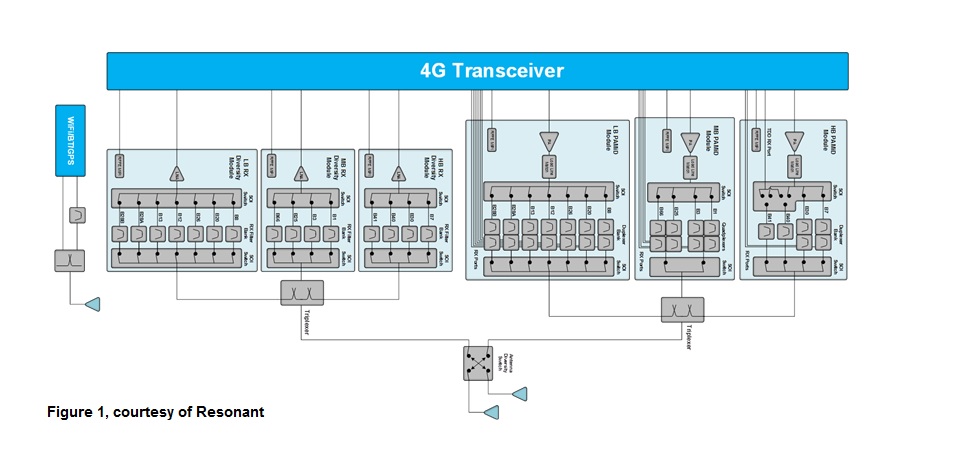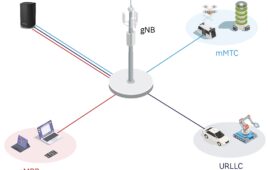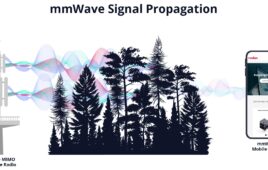Today’s 4G smartphones and other mobile devices have a radio frequency front end (RFFE) that must support on average 20 frequency bands using more than 40 filters, which means a unique RF filter – the device needed to isolate the right radio wave – for each RF path. This marks a significant advance in complexity compared to 2G/3G phones. But these devices pale in comparison to the RFFE complexity needed to support 5G, where I anticipate more than 100 RF paths for worldwide support and increased data-rate will be needed to for the emerging worldwide wireless standards that will make up 5G.
The 5G technology standard for mobile devices is still in development. But enough information is known to imagine how manufacturers will need to structure the RFFE for this generation. Some of the key trends include:
High Frequency Spectrum (>6 GHz): With almost all the available spectrum below 6 GHz now allocated, carriers will be forced to move to higher frequency spectrum to secure bandwidth. However, as the frequency increases, RF propagation is reduced, and penetration into buildings suffers. Thus, the bandwidths available above 6 GHz lend themselves to short range, point-to-point, line-of-site connections (likely in-building). Traditional network planning becomes difficult, but a much higher frequency, millimeter wave (mmWave or near mmWave e.g. 28 GHz) mesh network could work in dense urban environments. While components are generally smaller as frequency increases, reduced semiconductor performance at these higher frequencies will impact cost and power consumption.
Massive MIMO: MIMO is already used in LTE and LTE-Advanced networks, where multiple antennas are deployed either at the base station or mobile device (or both) to improve the link. However, massive MIMO is used in this context to leverage a large number of antennas in order to allow spatial beamforming, so that the energy can be focused directly at the user’s device, and electronically steered to track with the device’s movements. Large increases in capacity are possible by generating multiple beam paths. Although this technology has been experimentally verified, significant advances in processing and interoperability will be required for wide-scale deployments.
Interference Mitigation: 5G demands use of large spectrum bandwidths and massive overlapping of cells, which will result in both in-band and out-of-band interference. In general, 3G and early deployments of 4G were limited in their performance due to incomplete coverage. Performance within a cell was largely determined by signal-to-noise ratio (SNR). The extreme densification of the network envisioned for 5G will change the limitations from coverage to interference, and performance will be determined by the signal-to-interference + noise ratio (SINR). RF filters will play a critical role in improving SINR. In 4G, cell edge performance in urban environments is dominated by co-channel interference from overlapping cells. Electrical antenna tilt can help, but inter-cell interference coordination (ICIC) has been introduced to reduce the impact on cell edge users. ICIC uses different resource blocks for different users at the cell edge, which increases the effective re-use rate from 1 to 3. Enhanced ICIC (eICIC) will be required for 5G, where resource block allocation will be dynamic in the time domain. This will be essential for heterogeneous networks, where small cells are within the macro footprint.
New and Adaptable Waveforms: OFDMA is the waveform used in 4G networks because, by using sub-bands, the bandwidth is easily scalable, enabling higher data rates. However, OFDMA is susceptible to interference and procedures to allocate resources are inefficient for small (data or packet) payloads. Extensive investigation of more efficient orthogonal as well as non-orthogonal waveforms is underway to identify candidates for 5G. RF filters will play a critical role in OFDMA performance.
Implications for the 5G RF Front-End
The implications of 5G on the development of the RF front-end for mobile broadband devices will be significant. The current state-of-the-art for a mobile smartphone RF front-end separates the frequency spectrum into low-band (698 MHz-960 MHz), mid-band (1710 MHz-2200 MHz) and high band (2400 MHz-3800 MHz) frequencies, which isolates the RF components, minimizes cross-talk, and optimizes the entire power amplifier-filter-switch path. Although integration of components is logical, the increasing complexity of 5G limits the number of manufacturers that have the expertise to execute on such a complex RF sub-system.

Click to enlarge
As we move toward 5G, the complexity of the RF front-end increases. For instance, in addition to the main antenna path modules, diversity antennas provide both link robustness and increased downlink data rates. Designers are increasingly using receive diversity modules to process the diversity path, comprised of receive (Rx) filters and switches and, increasingly, incorporating low-noise amplifiers (LNAs). Wireless carriers demanding higher 5G data rates will drive more carrier aggregation, creating more potential interference.
Consequently, the onus on RFFE designers moving forward will be to reduce complexity, reduce cost, while at the same time improving performance. These represent a significant set of challenges for RFFE design and manufacturing.
The complexity of the 5G RFFE means that filters, in particular, must be smaller, faster, more power efficient, and able to be mass produced for an explosion of new 5G devices. The filter industry must consider these factors now in order that RF filters and RFFE design don’t limit or delay the evolution for 5G networks.
Note: This article has been excerpted from the whitepaper “RF Innovation and The Transition to 5g Wireless Technology.”
Mike Eddy is vice president of corporate business development and product marketing for Resonant Inc. Previously, he was president and founder of ANTONE Wireless, a provider of 4G network infrastructure enhancement products that was acquired by Westell Technologies, Inc. Before that, Eddy held several senior management positions at Superconductor Technologies Inc.




